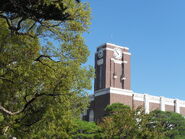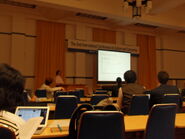EXPERIENCE REPORT
The Second International Conference on Culture and Computing 2011, Kyoto University, Kyoto, Japan
The Second International Conference on Culture and Computing was held in the beautiful historic city of Kyoto. It attracted researchers from various disciplines making it a platform for discussions on multi-disciplinary approaches. Personally speaking it was a right combination of computing and cultural and social studies professionals and researchers. The discussions were oriented towards the applicability of computing to social and cultural understanding and enhancement. The venue being one of the cultural capitals of Asia provided a right vibe for the discussions.
The conference started with the keynote lecture by Prof Shigeru Miyegawa of MIT, who discussed the phenomenon of inaccessibility being widely accessible. The freedom to access information which were only accessible to selected few is the theme of his talk which described two projects at Massachusetts Institute of Technology. One is OpenCourseWare, which has made course content from all MIT courses available freely on the Web. Over 1 million people have accessed these contents and tyhey were translated into several languages, which raised the question of how it would affect the learning and communication across cultures. Second project in his talk is Visualizing Culture, which provide free access to historically valuable images from major museums, such Boston Museum of Fine Arts and Smithsonian Institute. It intrigued me into asking the question of copyright and ownership, which incidentally, at IEEE-SocialCom 2011 was discussed by Joi Ito in his keynote. Joi Ito mentioned the idea that acknowledgement of the copyright would benefit the copyright holder more than the intricate laws. My question to Prof Miyagawa is whether there are steps taken towards securing copyrights in the Visualizing Culture project. His answer is that since those images are in small scale it will not be useful in commercial purposes. Where the developing countries with their rich cultures and limited resources would feature in this kind of a scheme is little ambiguous.
The conference was in two sessions, the main track and special track and in between these parallel sessions there were several workshops on intercultural collaborations and interdisciplinary approaches. The main track sessions were on broad themes while special track sessions concentrated on specific themes. The main track sessions started with paper presentations on the theme of Communication and Culture. One of the papers I collaborated with Prof Nakatsu was presented by Prof Nakatsu on this session, which was discussed in terms of the contents relative merits to the society.
The second session of Main track discussed the intercultural collaborations. The machine translation and the difficulty it presented in communication between cultures were discussed in length. Asian culture based media art in special track sessions mostly discussed the use of traditional art such as Waka poetry and Wyang Kulit puppetry in computing. A paper written by Eng Tat Khoo, Roshan Peiris and Matthias Rauterberg was presented by Mattias Rauterberg at this session. I presented a special track paper which I collaborated with Prof Nakatsu at the second Asian Culture based Media Art session. The discussion after the paper was what is the role of the social networks and whether that role is relatively new in comparison to the social networking history.
I presented my poster on the last day of the conference, which attracted several interested individuals. The discussion varied with the questions about the theoretical approach and the robustness of the case study. The spatial theory and social networking is admired as a new combination and there were few high encouragements from various intellectuals.
The various perspectives presented and the strong pull towards integrating day to day cultural activities and traditional cultural aspects into computing was the special appeal of the conference. The tendency of the participants towards an inspired attitude towards a harmony of traditions, cultures and societies and computing is refreshing to a person like me who is sitting uneasily on the border.





